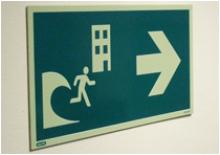Caribbean Region To Adopt ISO Tsunami Signage
Caribbean Region To Adopt ISO Tsunami Signage
ISO 20712 provides specifications and guidance on safety signs for aquatic hazards. These include internationally agreed signage for a tsunami hazard zone, evacuation area and evacuation building.
Caribbean tsunamis
Since 1498 there have been at least 94 tsunamis with run-ups reported in the Caribbean region causing 4 652 casualties. Most of these tsunamis were associated with submarine earthquakes, but the Caribbean Sea region has all of the potential tsunami-generating sources, including submarine earthquakes, sub-aerial or submarine landslides, and volcano activity.
Tsunami flood modelling has been performed for all of Puerto Rico and several localities in French Antilles, Bridgetown in Barbados and several localities in northern Venezuela. In addition to the 40 million people living in the region, 22 million tourists visited the Caribbean in 2007 and 2008 – a growing trend, which makes the region extremely vulnerable to high-casualty tsunamis, at least for those risk-prone areas that are not covered by an end-to-end tsunami warning system.
Early warning systems
Early warning systems are essential components of any preparedness effort aimed at reducing the risk, or mitigating the impact of natural hazards. The December 2004 Indian Ocean Tsunami triggered an enormous effort to build early warning systems in the Indian Ocean basin.
Early warning systems are highly complex structures requiring scientific expertise in risk assessment, hazard identification and interpretation, telecommunications, dissemination and communication tools and mechanisms, and efficient coordination and management skills. Modern early warning systems embrace the end-to-end concept, which implies concatenated technical and social machinery for rapid response from the top level to the last mile.
The global impact of the Indian Ocean tsunami tragedy triggered the development of early warning systems in other basins that also have tsunami hazards. In the Caribbean, Mediterranean and North East Atlantic, similar systems have been developed to deliver warnings. Again, millions of dollars are involved in these initiatives.
The initial focus on wide basin alert systems, mostly developed in the Pacific Ocean after the 1960 Southern Chilean earthquake and tsunami, has moved towards development of capabilities to detect and warn of more frequent tsunamis that can have a regional and/or local effect, instead of less frequent wide-basin ones.
Tsunami signage as part of preparedness
By improving knowledge and preparedness before a tsunami, fatalities and property damage can be reduced. Concerned communities need to be aware and prepared for tsunami hazards that are infrequent and not linked to seasons or daytime patterns.
Science is providing precise tools to determine potentially floodable areas. A participatory approach to territorial planning process may help define tsunami risk areas. Inundation maps – defined either by using historical and/or modelling studies – provide the basic layer where emergency managers can designate evacuation areas, routes and safe zones or shelters.
At this point, harmonized tsunami signage can be an integral part of a community’s effort to build and sustain preparedness against tsunamis, by reminding both locals and tourists on the dangers of tsunamis, providing by the same opportunity the basic information to get to safer areas in case of a tsunami attack.
The ISO-approved signage consists of three signs:
– Tsunami Hazard Zone – To warn of a hazard from tsunami waves
– Tsunami Evacuation Area – To indicate the location of a safe place/uphill area for evacuation to, in the event of a tsunami
– Tsunami Evacuation Building – To indicate the location of a safe building for evacuation in the event of a tsunami
Bernardo Aliaga has been with the Intergovernmental Oceanographic Commission of the United Nations Educational, Scientific and Cultural Organization (UNESCO) since July 2001. He is presently the Technical Secretary for the Intergovernmental Coordination Group for the Tsunami and Other Coastal Hazards Warning System for the Caribbean and Adjacent Regions.
Caribbean countries have agreed to consider adopting the graphical symbols included in the ISO 20712 series on water safety and beach flag signs.”
“Harmonized signage can be an integral part of a community’s effort to build and sustain preparedness against tsunamis.”
Jalite plc have been producing quality photoluminescent safety products for over 30 years, including Tsunami signs, fire safety signs, health and safety signs, safety wayguidance systems and photoluminescent paint and safety tape.
For more information regarding Jalite products please visit www.jalite.com

